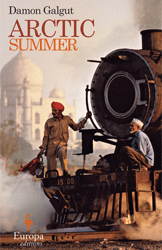As a Halloween treat, we are pleased to bring you an interview with dark fable writer, Sebastian Gregory:
| A Portrait of the Author and Friend. |
Seb, thank you so much for joining us on our blog today. I'd like to start by telling you how much I
enjoyed both The Asylum For Fairy-Tale Creatures and The Boy in the
Cemetery. They were wonderfully creepy
tales. What is it about fairy tales and
fables that inspires you?
Thank
you for having me and taking the time to read my stories. I think the thing I like about fairy tales as
inspiration is how they can lend themselves to different situations and
stories. They can be re told a thousand
times over and still be fresh, or they can be changed completely while
retaining certain themes that make them instantly recognisable.
Your books certainly do have violence, but
they aren't overly graphic. What's your
opinion on some of the more graphic, spatter horror that's out there?
I
think violence can be a necessary part of a story, however personally I prefer
something to be sinister than gory, I think it makes a more interesting
experience.
On
a serious note, with the exception of horror's golden period in the 1980's and
1990's, horror has always been sort of considered the bastard child of the
publishing industry. It's harder and
harder to find bookstores with horror sections.
Dean Koontz, a past president of the Horror Writer's Association (HWA),
decided that he didn't want to be known as a horror writer and many mainstream
publishers simply stopped publishing it.
But you seem to revel in the genre.
Why take on what may be an uphill battle?
I
wouldn’t consider myself a horror writer as such. I just happen to write dark themes,
strangely though I would say they are a playful type of darkness, yes I have a
zombie boy in my story, but he’s very childlike and real. I think the scenes grounded in reality are
more horrid than the supernatural ones.
However when I was younger I did
emulate the classic horror writers, Stephen King, Clive Barker, Dean Koontz, Shaun Houston. I think that kind of horror still exists
today but in other forms, it’s become more sophisticated and psychological, this
most evident in movies than anything.
What do you see as the future of the genre?
More zombies? Realistic
horror? New Monsters?
I
can see the generic monsters always being relevant because the way the stories
are told. Just as a creature becomes
tiresome, someone will make it interesting again. The walking dead is the best example of
this. On paper its just zombies again,
however it is so much more than that on many levels. Then of course they will be new creatures
waiting in the shadows to drag us in.
And on a lighter note, have you had any real experiences with 'things
that go bump in the night' that you can share with our readers?
Everyone
has a bump in the night story or something they cannot explain. I am not sure if this makes it supernatural
or not, however life would be dull if the supernatural did not exists in one
form or other. I do share my experiences
however, they are in my books!
If
our some of our readers haven't had the chance to experience your books yet,
where should they start and why?
I would start with The Boy in the
Cemetery as this the most accessible and the one more personal to me. From then
on Alice or Asylum are very similar in scope and style. All my books would be
good for anyone who likes fairytales with a touch of the macabre.
Finally, what's in the future for Sebastian Gregory? What can our readers look forward to next?
In
December Carinauk will be publishing “A Christmas Horror Story.” It’s about
three children left alone on Christmas Eve, when Das Kinderfresser ( a German
folk tale monster) comes to visit. I am
not sure what 2015 holds yet, but I have a few ideas.
Thank you so much for taking the time to talk
to us today. We look forward to your
next creepy tale!
About Sebastian:
Sebastian Gregory
(Pronounced Gre-gory) writes from a cabin in the middle of a haunted wood. His
inspiration comes from the strange and sorrowful whispers amongst the ghastly-
looking trees. From the shadowy candle light of the cabin Sebastian is only
permitted to leave once a story is complete, where it is unleashed upon the
world of the living. Sebastian writes for the younger readers as they are
easier to terrify than adults whose imaginations died long ago. When not
writing in a cabin in the middle of a haunted wood, Sebastian lives in
Manchester with his family and various animals. You can email Sebastian on writtenbyseb@hotmail.co.uk, he
would love your feedback. You can follow him on Twitter @wordsbyseb
THE GRUESOME
ADVENTURES OF ALICE IN UNDEADLAND is .99 for a limited time on Amazon, Apple and other retailers.
Look out for A
CHRISTMAS HORROR STORY, coming in December.






















